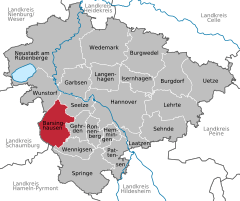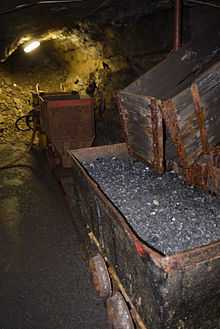Barsinghausen
| Barsinghausen | ||
|---|---|---|
| ||
 Barsinghausen | ||
Location of Barsinghausen within Hanover district 
 | ||
| Coordinates: 52°18′0″N 9°28′52″E / 52.30000°N 9.48111°ECoordinates: 52°18′0″N 9°28′52″E / 52.30000°N 9.48111°E | ||
| Country | Germany | |
| State | Lower Saxony | |
| District | Hanover | |
| Subdivisions | 18 district | |
| Government | ||
| • Mayor | n.n. | |
| Area | ||
| • Total | 102.65 km2 (39.63 sq mi) | |
| Elevation | 142 m (466 ft) | |
| Population (2012-12-31)[1] | ||
| • Total | 33,062 | |
| • Density | 320/km2 (830/sq mi) | |
| Time zone | CET/CEST (UTC+1/+2) | |
| Postal codes | 30890 | |
| Dialling codes | 05105 | |
| Vehicle registration | H | |
| Website | www.barsinghausen.de | |
Barsinghausen is a town in the district of Hanover, in Lower Saxony, Germany. It is situated at the Deister chain of hills approx. 20 km west of Hanover. Barsinghausen belongs to the historic landscape Calenberg Land and was first mentioned in 1193.


Geography
Neighbouring places
Barsinghausen adjoins Wunstorf, Seelze, Gehrden, Springe, Bad Nenndorf and Wennigsen.
Division of the town
Barsinghausen consists of 18 districts: Bantorf, Barrigsen, Barsinghausen, Eckerde, Egestorf, Göxe, Großgoltern, Nordgoltern, Groß Munzel, Hohenbostel, Holtensen, Kirchdorf, Landringhausen, Langreder, Ostermunzel, Stemmen, Wichtringhausen, Winninghausen
History
Barsinghausen is the site of an old double monastery (“Kloster Barsinghausen”) that was established during the High Middle Ages. At that time, fertile loess soil and a number of influent streams to river Südaue constituted a central fundament for farming and numerous windmills in Calenberg Land. Barsinghausen became a coal mining town between 1871 and 1957. After World War II, other sectors of industry began to dominate Barsinghausen's economy.
Population History
(each time at 31 December)
- 1998 - 34,743
- 1999 - 34,648
- 2000 - 34,497
- 2001 - 34,408
- 2002 - 34,370
- 2003 - 34,376
- 2004 - 34,253
Main sights
Barsinghausen is home to “Kloster Barsinghausen” a nunnery first mentioned in 1193 AD (now a Lutheran women's convent, to Monastery Church St. Mary (“Marienkirche”), to the Deister Open Air Theater (“Deister Freilichtbühne”), to the exhibition mine “Klosterstollen”, to Sport Hotel Fuchsbachtal and to Lower Saxony's Soccer Association.
Schools
Elementary schools
- Adolf-Grimme-Schule
- Wilhelm-Stedler-Schule
- Ernst-Reuter-Schule
- Astrid-Lindgren-Schule
- Albert-Schweitzer-Schule
- Grundschule Groß Munzel
- Grundschule Hohenbostel
- Grundschule Bantorf
Secondary Schools
Special Schools
- Bert-Brecht-Schule (Special education school)
- VHS (Volkshochschule - Adult high school) Calenberger Land
References
External links
| Wikimedia Commons has media related to Barsinghausen. |
- Official site (German)
| |||||||
